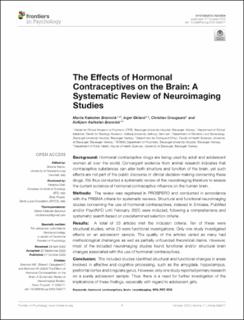| dc.contributor.author | Brønnick, Marita Kallesten | |
| dc.contributor.author | Økland, Inger | |
| dc.contributor.author | Graugaard, Christian | |
| dc.contributor.author | Brønnick, Kolbjørn Kallesten | |
| dc.date.accessioned | 2021-04-26T12:28:37Z | |
| dc.date.available | 2021-04-26T12:28:37Z | |
| dc.date.created | 2020-11-03T22:31:06Z | |
| dc.date.issued | 2020-10 | |
| dc.identifier.citation | Brønnick, M.K., Økland, I., Graugaard, C., Brønnick, K.K. (2020) The Effects of Hormonal Contraceptives on the Brain: A Systematic Review of Neuroimaging Studies. Frontiers in Psychology, 11., DOI: 10.3389/fpsyg.2020.556577 | en_US |
| dc.identifier.issn | 1664-1078 | |
| dc.identifier.uri | https://hdl.handle.net/11250/2739636 | |
| dc.description.abstract | Background: Hormonal contraceptive drugs are being used by adult and adolescent women all over the world. Convergent evidence from animal research indicates that contraceptive substances can alter both structure and function of the brain, yet such effects are not part of the public discourse or clinical decision-making concerning these drugs. We thus conducted a systematic review of the neuroimaging literature to assess the current evidence of hormonal contraceptive influence on the human brain.
Methods: The review was registered in PROSPERO and conducted in accordance with the PRISMA criteria for systematic reviews. Structural and functional neuroimaging studies concerning the use of hormonal contraceptives, indexed in Embase, PubMed and/or PsycINFO until February 2020 were included, following a comprehensive and systematic search based on predetermined selection criteria.
Results: A total of 33 articles met the inclusion criteria. Ten of these were structural studies, while 23 were functional investigations. Only one study investigated effects on an adolescent sample. The quality of the articles varied as many had methodological challenges as well as partially unfounded theoretical claims. However, most of the included neuroimaging studies found functional and/or structural brain changes associated with the use of hormonal contraceptives.
Conclusion: The included studies identified structural and functional changes in areas involved in affective and cognitive processing, such as the amygdala, hippocampus, prefrontal cortex and cingulate gyrus. However, only one study reported primary research on a purely adolescent sample. Thus, there is a need for further investigation of the implications of these findings, especially with regard to adolescent girls. | en_US |
| dc.language.iso | eng | en_US |
| dc.publisher | Frontiers Media S.A | en_US |
| dc.rights | Navngivelse 4.0 Internasjonal | * |
| dc.rights.uri | http://creativecommons.org/licenses/by/4.0/deed.no | * |
| dc.subject | prevensjon | en_US |
| dc.subject | hormonell prevensjon | en_US |
| dc.subject | kvinnehelse | en_US |
| dc.subject | nevrologi | en_US |
| dc.title | The Effects of Hormonal Contraceptives on the Brain: A Systematic Review of Neuroimaging Studies | en_US |
| dc.type | Peer reviewed | en_US |
| dc.type | Journal article | en_US |
| dc.description.version | publishedVersion | en_US |
| dc.rights.holder | Copyright © 2020 Brønnick, Økland, Graugaard and Brønnick. | en_US |
| dc.subject.nsi | VDP::Medisinske Fag: 700::Klinisk medisinske fag: 750 | en_US |
| dc.source.pagenumber | 18 | en_US |
| dc.source.volume | 11 | en_US |
| dc.source.journal | Frontiers in Psychology | en_US |
| dc.identifier.doi | doi.org/10.3389/fpsyg | |
| dc.identifier.cristin | 1844709 | |
| cristin.ispublished | true | |
| cristin.fulltext | original | |
| cristin.qualitycode | 2 | |

